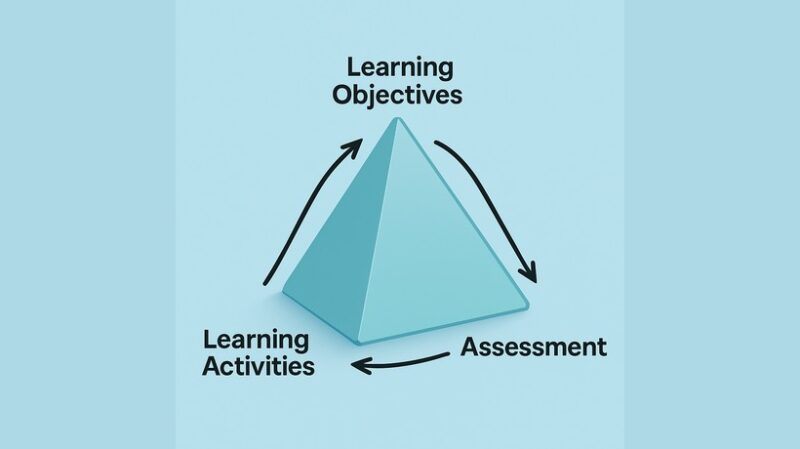
Understanding the Magic Triangle of Learning
Have you ever pondered why certain training programs achieve remarkable results while others fall flat? Many people find themselves completing a course, receiving a certificate, yet struggling to recall the material later. Conversely, some training experiences resonate deeply, leading to lasting application of newfound knowledge. The key lies in course structure, and this is where the Magic Triangle of Learning comes into play.
This innovative framework incorporates three fundamental elements essential for an impactful learning experience: learning objectives, activities, and assessments. When these elements work harmoniously, learning becomes purposeful, engaging, and memorable. Picture a triangle with dynamic arrows flowing between each vertex: objectives guide activities, activities prepare learners for assessments, and assessments evaluate the fulfillment of objectives. This concept draws from Instructional Design, particularly the principle of constructive alignment, a term advocated by educational theorist John Biggs. It’s a widely adopted strategy in both academic and corporate training due to its effectiveness. Let’s delve into how this triangle operates, especially within the realm of eLearning.
The Three Cornerstones of the Magic Triangle of Learning
Cornerstone 1: Learning Objectives
Learning objectives are the backbone of any well-structured course or training initiative. They provide a clear direction for learners and prevent instructors from crafting courses that lack purpose. Effective learning objectives are specific, measurable statements detailing what learners should achieve by the end of a session or module. When developing your objectives, opt for active verbs like “identify,” “create,” “analyze,” or “apply.” Focus on the learners’ outcomes rather than what you intend to teach, and ensure alignment with larger goals—be it organizational objectives, compliance requirements, or personal development.
Cornerstone 2: Learning Activities
While learning objectives indicate what knowledge or skills students need, learning activities focus on how to reach those goals. These interactive experiences promote the absorption, application, and retention of new concepts. Activities may include group discussions, engaging eLearning modules, case studies, role-playing games, and more. The aim is to foster active engagement, allowing learners to interact with the material rather than passively consume it. However, not all activities are equally effective; they should be closely connected to your learning objectives. For instance, if the goal is to teach conflict resolution, a role-playing exercise will be significantly more beneficial than a simple quiz. Additionally, recognizing diverse learning styles by incorporating varied activities helps maintain engagement and yields meaningful learning experiences.
Cornerstone 3: Assessment
Once you’ve established clear objectives and designed compelling activities, how do you measure effectiveness? Enter assessments, the third cornerstone of the Magic Triangle of Learning. These tools gauge whether learners have achieved your objectives. There are two primary types: formative and summative. Formative assessments serve as checkpoints—think short quizzes, discussion prompts, or feedback during activities—to help learners stay aligned with their goals. On the other hand, summative assessments occur at course completion, such as final projects, presentations, or skill demonstrations, providing insight into the overall learning effectiveness. The crucial element remains alignment; your assessments should directly relate to the defined objectives from the outset.
The Impact of Alignment
What occurs when learning objectives, activities, and assessments are in sync? The result is clear, purposeful, and effective learning. Such alignment fuels motivation; when learners grasp the connection between their goals, the content, and what defines success, their confidence soars. This eagerness translates into deeper engagement, as they recognize the relevance of the material and how it influences their evaluation. For Instructional Designers, alignment simplifies the design process, facilitating the selection of effective activities and the development of meaningful assessments.
Consequences of Misalignment
Even well-structured learning programs can falter if any aspect of the triangle is off. A prevalent issue arises when activities feel disconnected from the learning objectives. If learners are unable to link an activity to their goals, motivation wanes and genuine learning suffers. Furthermore, assessments that diverge from the taught material can lead to frustration; learners may invest time understanding a concept through videos and examples, only to face a test on unrelated or theoretical content. Such disconnection breeds confusion and hampers retention.
Implementing the Magic Triangle in eLearning
Articulated Objectives
When crafting objectives for your eLearning course, favor precise, actionable, and measurable statements over vague goals. This clarity ensures that learners understand your expectations, and instructional designers can build effectively around them.
Intentional Activities
In the world of eLearning, creativity is key in designing impactful activities. Rather than leaning on passive techniques like slides or lectures, opt for interactive experiences with real-world relevance. Consider scenarios where learners make choices and observe the consequences, immersive narratives, or simulations.
Significant Assessments
Many eLearning assessments merely check for rote recall instead of assessing practical application. In reality, learners must demonstrate their ability to utilize what they’ve learned. To create meaningful assessments, question whether a test effectively reveals whether a learner can meet the set objective. For example, if the objective is to learn how to manage a Google Ads campaign, assign a project where learners create and run a mock campaign.
Leveraging Data and Analytics
One of the standout advantages of digital learning is the wealth of data available. You can track what learners engage with, how long they spend on courses, where they disengage, and identify common errors. The challenge lies in leveraging this data. If you discover that learners struggle with a particular activity, think about areas for improvement. Similarly, if a course section sees high abandonment rates, consider strategies to enhance engagement.
Final Thoughts
Whether you’re developing a university course, a corporate training program, or an online module, the Magic Triangle of Learning is your guide to effective design. Ensuring alignment between objectives, activities, and assessments guarantees meaningful learning experiences. By adopting this framework, you empower learners to grow, build skills, and acquire knowledge they can genuinely apply. Start with the triangle in mind, and you’ll find it transforms your approach to instructional design.



